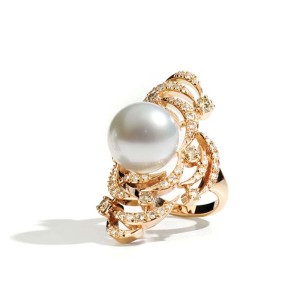Planting a seed

It’s no wonder the pearl was one of the first gems to be prized. Fresh out of the shell, these wonders could be worn and admired without any of the polishing and fashioning required by other stones. How they are formed is also quite different from other gems.
A pearl is the result of a mollusk’s self-defence mechanism—its response to an irritant. The intrusion can be something like a parasitic worm that has found its way inside, or it can be purposely introduced into the mollusk’s body by human hands. When created as a result of a natural intrusion, the pearl is referred to as ‘natural’; however, when a human contributes to its formation by implanting an irritant, it’s called a ‘cultured’ pearl.
The process is the same for either a natural or cultured pearl. To protect itself, the mollusk forms a sac around any invader that gets inside its body. This sac secretes nacre to cover the irritant. The nacre and sac materials are made by the mollusk’s mantle, the layer of tissue surrounding its body and lining the shell. The mantle tissue cells that make up the pearl sac are called epithelial cells.
A cultured pearl is created via two methods: bead nucleation and tissue nucleation. Bead nucleation is the method used for saltwater oysters. Here, nucleators surgically implant a bead nucleus and a small piece of mantle tissue in or near the animal’s gonad, or reproductive organ. Bead nuclei are typically made from freshwater mussel shells found in North America, while mantle tissue comes from a donor mollusk.
Tissue nucleation is used for the majority of freshwater mussels. This process requires a nucleator implant a piece of mantle tissue into a mussel, rather than a bead. Another difference is that the nucleator places the tissue in the wide, fleshy mantle area, instead of the gonad.
When nucleation is successful, the mussel deposits layers of nacre around the mantle tissue, forming a cultured pearl. Since there is no bead nucleus, a tissue-nucleated cultured pearl is almost entirely composed of nacre.
The majority of pearls today are of the cultured variety. While there are still some natural pearls being harvested in the Middle East, the quantities are very small and their shapes irregular.





